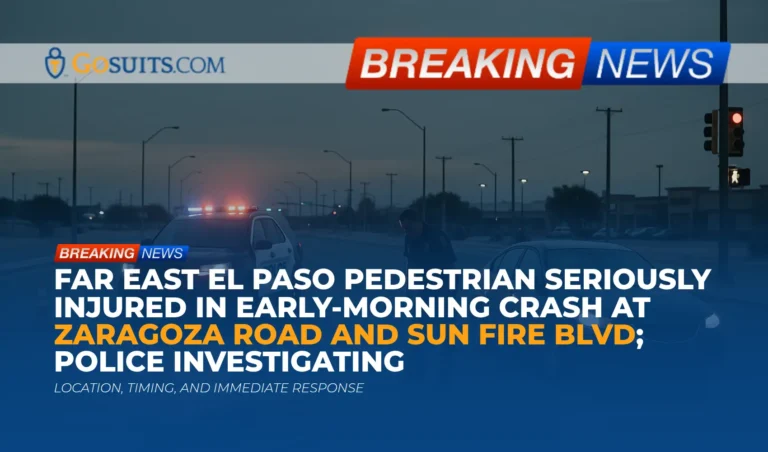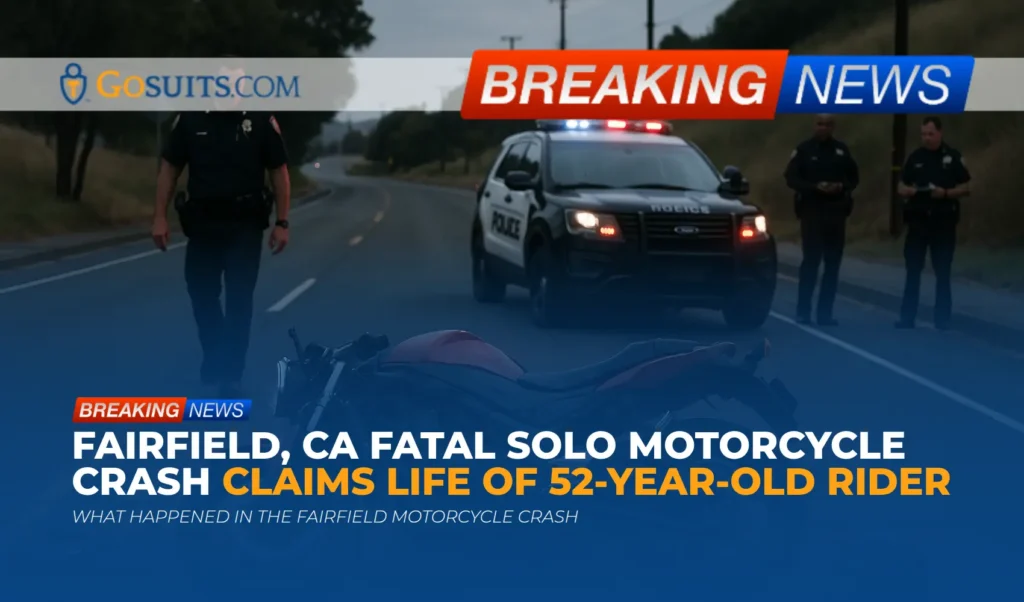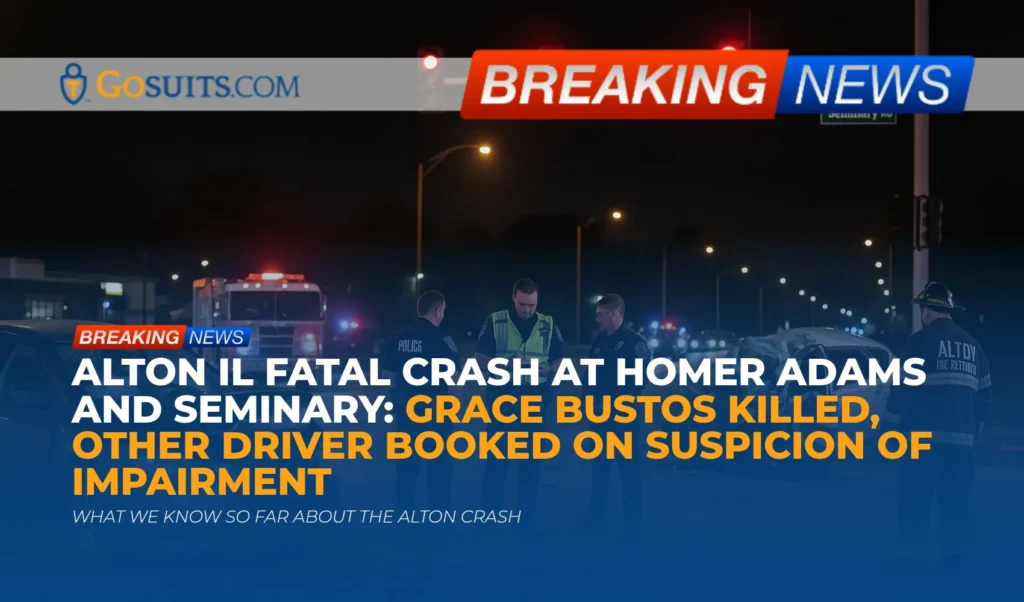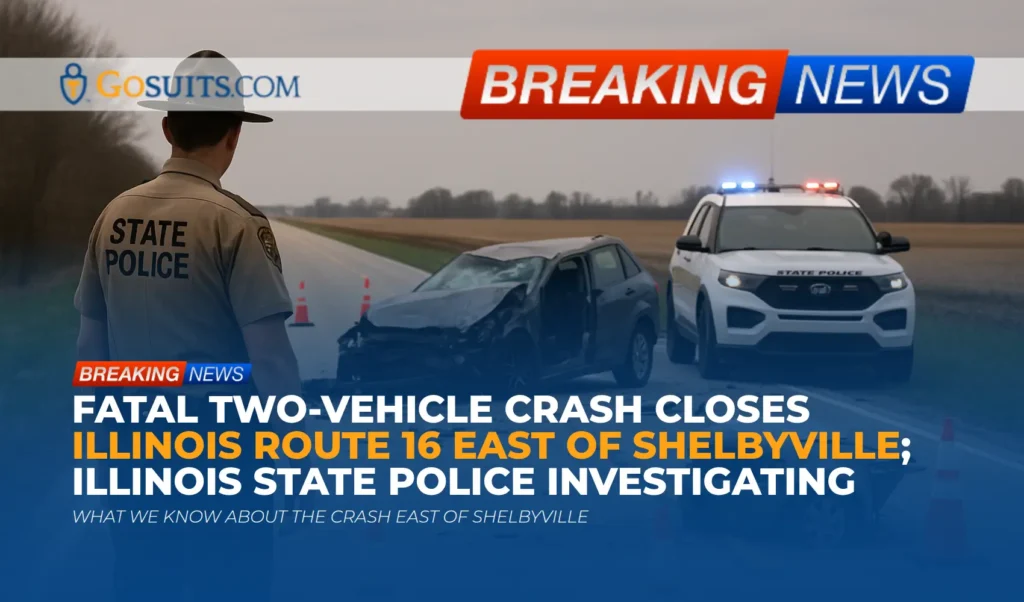- What we know about the Far East El Paso pedestrian crash
- Location, timing, and immediate response
- Why pedestrian crashes often happen in early morning hours
- Rights of injured pedestrians under Texas law
- Potential civil liability considerations in a pedestrian-vehicle crash
- Evidence to preserve as soon as possible
- Where to obtain official records and updates
- Medical care, follow-up, and careful documentation
- Insurance coverages and common pitfalls after a crash
- How roadway and traffic conditions can contribute
- Key Texas deadlines and procedures to keep in mind
- Practical next steps: time-sensitive actions to consider
- Commentary from Gosuits El Paso, Texas Personal Injury Attorney
What we know about the Far East El Paso pedestrian crash
Early this morning in Far East El Paso, a pedestrian was struck by a vehicle near the intersection of Zaragoza Road and Sun Fire Boulevard. According to information released by El Paso Police, the crash occurred just before 5:30 a.m. The pedestrian sustained serious injuries and was transported to a hospital. Special Traffic Investigators (STI) from the El Paso Police Department responded to the scene to determine what happened and to document the evidence. At the time of this writing, further details about the driver, exact circumstances, and the pedestrian’s current condition have not been publicly released.
It is natural for families and community members to feel anxious and want clear answers. Crash investigations typically proceed through on-scene documentation, witness interviews, measurements, and later analysis of vehicle and roadway evidence. Updates may follow once investigators complete initial steps and reports become available through official channels.
Location, timing, and immediate response
The collision site sits along Zaragoza Road at Sun Fire Boulevard in Far East El Paso, a busy corridor that serves commuters and local traffic. The time of the crash—just before dawn—often presents low-light conditions, potentially cooler morning temperatures, and commuting traffic patterns. Emergency responders transported the injured pedestrian to a hospital for treatment, and STI officers focused on collecting facts to reconstruct the event.
When Special Traffic Investigators are called, it generally indicates serious injury. Their role includes scene photography, roadway measurements, collision dynamics analysis, and sometimes vehicle inspections. This process supports potential civil claims by preserving objective details about speed, braking, lighting, visibility, and the positions of involved parties.
Why pedestrian crashes often happen in early morning hours
While the exact cause here remains under investigation, national research helps explain why the hours around dawn and dusk can be hazardous for people on foot. The Centers for Disease Control and Prevention notes that thousands of pedestrians are killed in crashes each year in the United States and that risk increases under low-light conditions. For broader context, see the CDC’s overview on pedestrian safety at cdc.gov.
The National Highway Traffic Safety Administration has reported that a large proportion of pedestrian fatalities occur in dark conditions and outside of intersections. NHTSA’s pedestrian safety page provides data-driven insights about common risk factors, which can inform both personal safety choices and community planning. Reference: nhtsa.gov.
Common contributing factors in early morning crashes may include limited visibility, glare from headlights, driver fatigue, higher prevailing speeds on wide arterials before peak congestion, and pedestrians attempting to cross multilane roadways where signalized or marked crosswalks are spaced far apart. None of these factors determine fault by themselves, but they help frame what investigators look for in assessing the circumstances.
Rights of injured pedestrians under Texas law
Texas law recognizes that motorists and pedestrians share duties on the roadway. Two provisions often cited in pedestrian cases are:
- Drivers’ duty of care: Motorists must exercise due care to avoid colliding with pedestrians and must sound the horn when necessary for safety. See Texas Transportation Code § 552.008.
- Reasonable and prudent speed: Drivers must operate at a speed that is reasonable and prudent for the conditions, including hazards like darkness or pedestrian activity. See Texas Transportation Code § 545.351.
Additional duties may apply at crosswalks and intersections. For example, pedestrians must follow traffic control devices and may have to yield when crossing outside of a crosswalk, but these rules do not eliminate a driver’s continuing duty to exercise care. See related pedestrian provisions in Chapter 552 of the Transportation Code at statutes.capitol.texas.gov.
When a pedestrian is injured, potential civil claims can include damages for medical expenses, lost wages, physical pain, and other losses. These claims usually proceed against the at-fault driver’s liability insurance. In some cases, additional coverages or defendants may be involved, as discussed below.
Potential civil liability considerations in a pedestrian-vehicle crash
Every crash is unique, and liability depends on specific facts. Investigators and insurers will consider:
- Driver conduct: Speed relative to the conditions, attentiveness, compliance with traffic controls, headlight use before sunrise, and evasive actions taken.
- Pedestrian actions: Crossing location (crosswalk or mid-block), visibility, compliance with signals, and whether the pedestrian was forced into the roadway by environmental factors.
- Roadway environment: Lighting, road width, lane count, traffic speed, presence of crosswalks or signals, and sight lines obstructed by landscaping or parked vehicles.
- Vehicle factors: Headlights functioning, windshield condition, and data from onboard systems if available.
Texas uses a comparative responsibility framework for civil cases. If a case proceeds to litigation, a finder of fact can allocate percentages of responsibility among the parties. Under Texas Civil Practice and Remedies Code § 33.001, a claimant barred from recovery only if their percentage of responsibility is greater than 50 percent. Otherwise, any recovery may be reduced by their assigned percentage. This framework makes careful fact development critical in pedestrian cases where visibility and roadway features play a big role.
Drivers also have duties after a crash, including providing information and rendering reasonable aid. See Texas Transportation Code § 550.023.
Evidence to preserve as soon as possible
Timely evidence preservation can make a real difference in understanding what happened and protecting one’s rights. Consider the following:
- Scene photos and videos: Capture the intersection, traffic signals, signage, lighting, skid marks, debris fields, and the approach paths. If possible, record at a similar time of day to reflect lighting conditions.
- Surveillance sources: Nearby businesses, residences with doorbell cameras, and transit or city cameras may have footage. Request preservation quickly; many systems overwrite video within days.
- Witness information: Names, phone numbers, and recorded statements (with permission) of anyone who saw the crash or its aftermath.
- Vehicle inspection: Headlight functionality, windshield condition, event data recorder information, and any dashcam footage.
- Medical records and injury documentation: Emergency room records, follow-up notes, imaging reports, and a journal tracking pain, mobility, and how injuries affect daily life.
- Clothing and personal items: Preserve the pedestrian’s clothing and shoes worn during the crash; these can show impact points, lighting/reflectivity, and damage patterns.
If an insurer reaches out early for a recorded statement, it is prudent to pause and obtain a free consultation with a seasoned attorney first. Statements given before the facts are fully known can be misinterpreted or used to minimize claims later.

Where to obtain official records and updates
Public records help clarify the facts. Availability and timing vary, but the following sources are commonly used in Texas:
- El Paso Police Department crash report and records: EPPD compiles a Texas Peace Officer’s Crash Report. Once processed, certified copies are generally available through the Texas Department of Transportation (TxDOT) Crash Records system. For general release provisions, see Texas Transportation Code § 550.065. TxDOT’s crash report portal is here: cris.dot.state.tx.us, and TxDOT information on crash reports is at txdot.gov.
- Police incident report and 911 recordings: Non-crash incident records and audio may be subject to the Texas Public Information Act. Public access has exceptions for sensitive information, but many records can be requested. See the Texas Attorney General’s open government guidance at texasattorneygeneral.gov.
- Emergency medical services and hospital records: These are generally protected health information and require proper authorization to obtain. Treating providers can guide patients through release forms.
- Medical examiner records (fatal cases only): In the tragic event of a fatality, a county medical examiner or justice of the peace may conduct an investigation. Autopsy and investigative records are subject to specific rules under Texas law, and next of kin can request information in accordance with those rules.
If requesting records for insurance purposes, consider consulting a lawyer first, as the sequence and content of requests can affect how an insurer evaluates a claim.
Medical care, follow-up, and careful documentation
Prompt and consistent medical care protects health and creates an objective record of injuries. Initial emergency care should be followed by recommended diagnostics and treatment plans. Keep copies of every discharge summary, imaging report, prescription, referral, and specialist visit, along with receipts for out-of-pocket expenses like medications, braces, or transportation to appointments.
Some crash-related injuries, including concussion, spinal soft tissue trauma, or internal injuries, may not be fully apparent in the first hours or days. Report new or worsening symptoms to a healthcare provider and follow medical advice regarding rest, activity limitations, therapy, and follow-up timing.
A simple journal can help capture the day-to-day impact: pain levels, sleep disruption, mobility limits, missed work, and activities that became difficult. This helps providers adjust treatment and gives insurers or a future jury a clearer window into the human consequences of the collision.
Insurance coverages and common pitfalls after a crash
Several insurance policies can come into play after a pedestrian-vehicle collision:
- At-fault driver’s liability insurance: This is typically the primary coverage for a pedestrian’s injury claim.
- Personal Injury Protection (PIP) or MedPay: In Texas, insurers must offer PIP; policyholders may reject it in writing. PIP can help with medical expenses and certain nonmedical costs regardless of fault. For an overview, see the Texas Department of Insurance’s auto insurance consumer guide at tdi.texas.gov.
- Uninsured/Underinsured Motorist (UM/UIM): If the at-fault driver has no insurance or insufficient limits, a pedestrian’s own UM/UIM coverage may provide additional protection.
Insurers often seek early statements and broad medical authorizations. What someone says to an insurance company can be used to reduce the value of a claim. Before giving a recorded statement or signing medical releases, it is advisable to speak with a lawyer and obtain a free consultation to understand rights and obligations. This includes deciding the order in which to notify insurers, identifying all coverages, and avoiding gaps in documentation that an insurer might later cite.
Be mindful of potential hospital and EMS liens in Texas. Hospitals that treat accident victims may assert a lien against a claim under Texas Property Code Chapter 55. See Property Code Chapter 55 for general provisions. Understanding these liens early can help with coordination of benefits and settlement planning.
How roadway and traffic conditions can contribute
Beyond individual behavior, the roadway environment can significantly influence crash risk and severity. Wide, high-speed arterials with long distances between controlled crossings encourage midblock crossings, especially where daily needs are on opposite sides of the street. Limited street lighting, tall landscaping near corners, and complex intersections can reduce visibility for drivers and pedestrians alike.
The Federal Highway Administration’s Safe System Approach emphasizes reducing crash forces on the human body through safer roads, safer speeds, safer vehicles, and more forgiving designs like better lighting and treatments that shorten crossing distances. For an overview, see FHWA’s Safe System resources at highways.dot.gov.
In Texas, agencies including TxDOT promote strategies like improved lighting, high-visibility crosswalks, pedestrian hybrid beacons, and speed management to reduce the risk of serious crashes. See TxDOT’s pedestrian safety campaign resources at txdot.gov.
While this information addresses general risk, the question of legal responsibility in any given case depends on the specific facts: traffic controls at the location, whether the pedestrian was in or near a crosswalk, driver behavior, line of sight, and other conditions present at the scene.
Key Texas deadlines and procedures to keep in mind
Deadlines can affect claims:
- Civil filing time limits: In most Texas personal injury cases, a two-year limitation period applies. See Texas Civil Practice and Remedies Code § 16.003. Certain claims may have shorter notice requirements, particularly when public entities are involved.
- Crash report availability: Crash reports are released under rules in Texas Transportation Code § 550.065, typically after they are processed. TxDOT’s system allows purchase of eligible reports.
- Insurance notification: Policies often require prompt notice. However, before contacting an insurer or giving a recorded statement, it is wise to consult an attorney to understand coverage, fault arguments, and the potential impact of statements.
If a government entity’s road design or signal maintenance is questioned, specialized notice rules may apply. These are highly fact-specific and time-sensitive.

Practical next steps: time-sensitive actions to consider
The period immediately after a serious crash is stressful. Clarity and timing matter. The following steps can help protect health, preserve facts, and maintain options:
- Prioritize medical care and follow-ups: Early evaluation and adherence to treatment plans protect health and create objective documentation that insurers use to assess claims.
- Secure the official crash report: Monitor availability through the TxDOT Crash Records portal. Having the certified report aids in claim submissions and helps confirm key facts.
- Preserve video and witness evidence quickly: Many systems overwrite in days. Request preservation from nearby businesses and residents and document those requests.
- Document expenses and lost income: Keep receipts, mileage logs for appointments, and employer letters verifying missed work or modified duties.
- Avoid recorded statements until after legal guidance: A free consultation with a qualified attorney before speaking to insurers can prevent common pitfalls. Statements can be used against the claimant later.
- Review all possible insurance coverages: Identify the driver’s liability policy, any PIP or MedPay, and UM/UIM. Confirm whether health insurance is involved and how liens may apply.
- Be mindful of deadlines: Calendar the two-year civil filing period and any shorter notice rules that might apply. Acting early allows a more thorough investigation.
Acting promptly helps ensure that evidence is preserved, medical recovery stays on track, and options remain open. Waiting can close doors: footage may be erased, witnesses may be hard to locate, and insurers may press for statements before the full picture is understood.
Commentary from Gosuits El Paso, Texas Personal Injury Attorney
Our thoughts are with the person injured near Zaragoza Road and Sun Fire Boulevard and with everyone affected. This article is intended to share general information and context about pedestrian crashes, investigations, and the civil process. It is not a substitute for personalized guidance. Crashes like this are traumatic, and we recognize how disorienting the hours and days afterward can be.
Based on what is publicly known, Special Traffic Investigators responded before dawn to a serious pedestrian injury. At this stage, it is too early to draw conclusions about fault. In pedestrian cases, careful attention is given to lighting, driver behavior under the conditions, crossing location and controls, line of sight, and roadway design. Texas law requires drivers to exercise due care to avoid pedestrians, and it expects pedestrians to follow signals and take care when crossing. Establishing what happened depends on meticulous fact-gathering, including surveillance footage, witness accounts, vehicle inspections, and the official crash report.
In our experience, insurance carriers and corporate defendants often move quickly after a serious crash to frame the narrative. Adjusters may request recorded statements, broad medical authorizations, or early settlements before injuries are fully understood. They rely on the natural gaps in knowledge that people have about claims, coverages, and Texas procedures. Seemingly simple answers about where someone was looking or how they felt right after impact may later be used to dispute fault or minimize injuries.
A free consultation can be an important first step toward leveling the playing field. It helps clarify which coverages apply, how to approach recorded statements, what evidence must be preserved immediately, and how hospital liens and other obligations might affect a potential recovery. Speaking with a skilled attorney before engaging with insurers can prevent avoidable missteps and ensure that decisions are made with a full understanding of the stakes.
For those monitoring this incident, keep an eye on the official crash report’s availability through TxDOT and any subsequent updates from investigators. As facts emerge, they will provide a clearer picture of the legal and safety issues involved, and they may inform community improvements that reduce the risk of future tragedies on Far East El Paso roadways.






